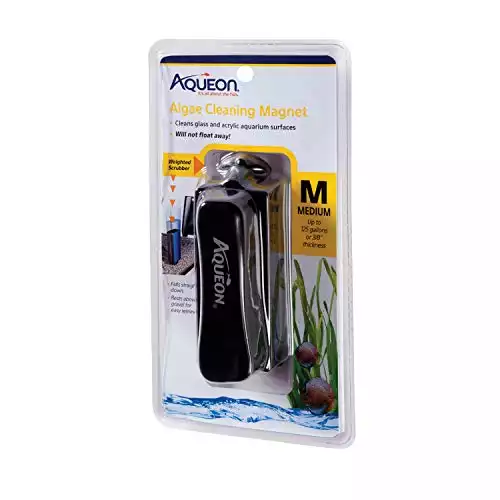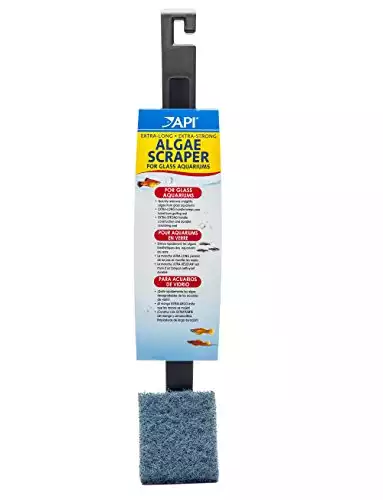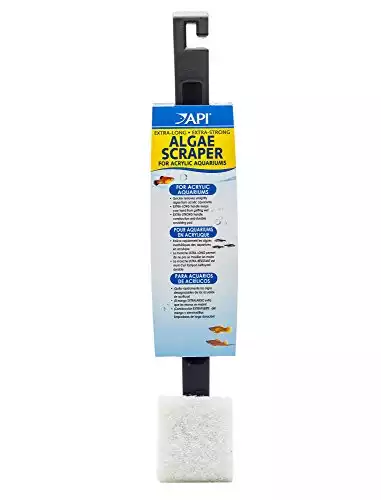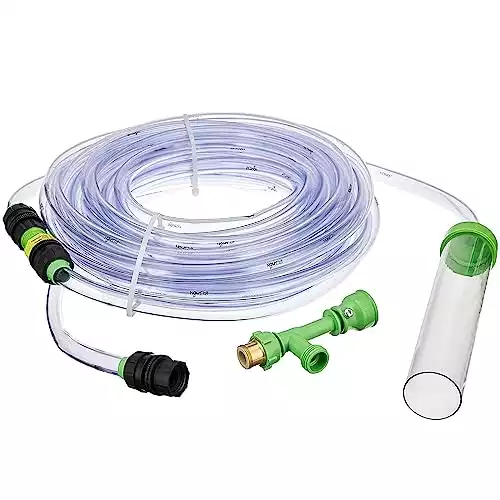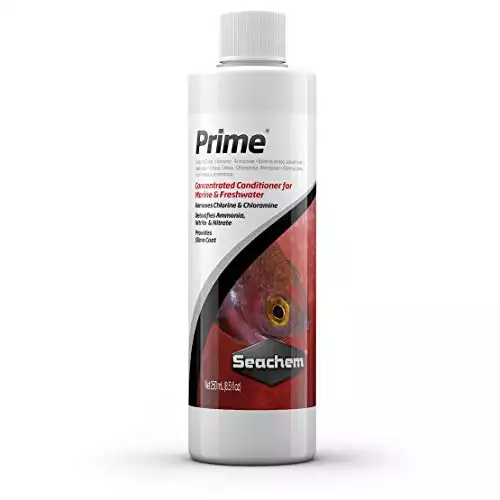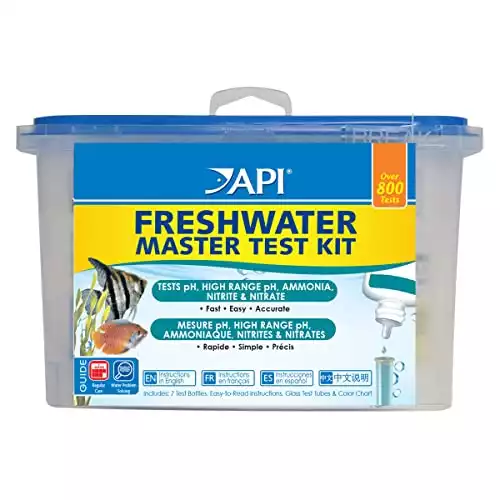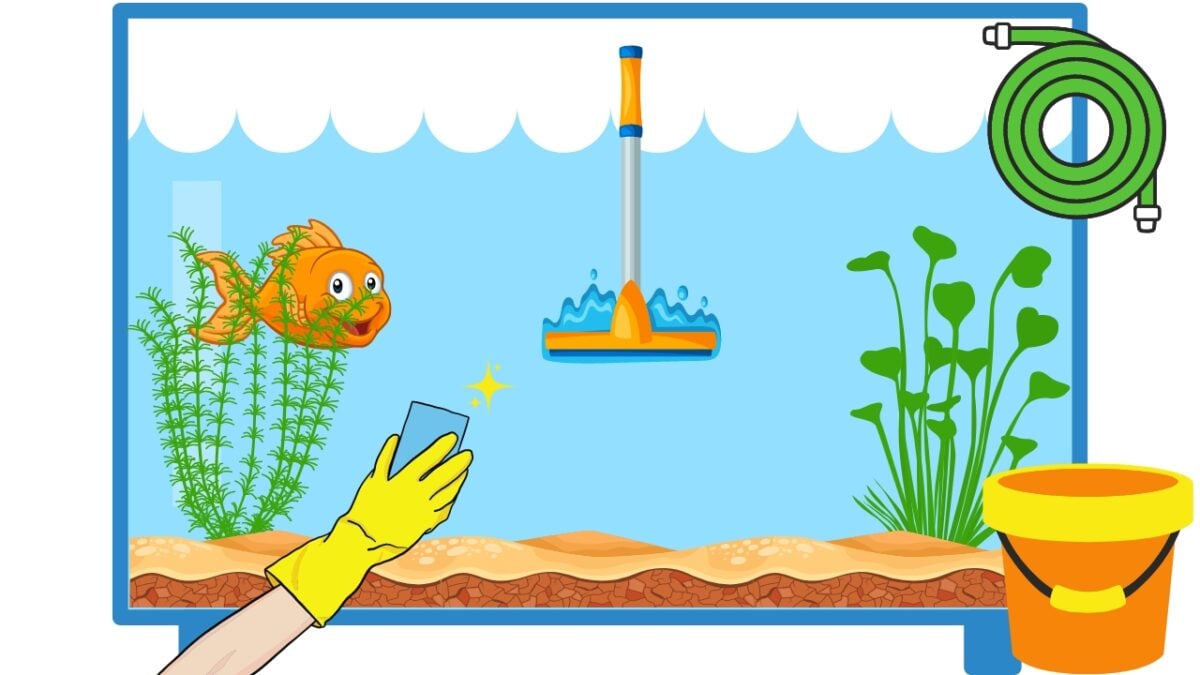
Nobody wants to look at a murky tank full of floaty bits and poop, and I’m pretty sure your fish will appreciate having a nice clean home.
Cleaning your fish tank not only makes it look great, but it also vastly improves the water quality ensuring your fish stay healthy.
6 Steps For How To Clean A Goldfish Tank Quickly & Easily
Let’s get straight into why you are here, follow these 6 simple steps to clean your tank effectively and keep your goldfish happy.
1. Clean Algae Off The Glass or Aryclic – As Needed
Algae is a natural part of the aquarium ecosystem, and while it can contribute to your tank’s overall health, it can also make it look dirty and reduce light penetration if too much grows.
Cleaning excess algae off the glass can be done on an as-needed basis.
Use a magnetic scrubber, a long-handle aquarium scrubber, or for stubborn algae a blade scraper (do not use blades on acrylic, your tank will be covered in scratches!).
4.6 | 4.5 | 4.5 | 4.5 |
$3.7817 | |||
As an Amazon associate, I earn from qualifying purchases. This is at no additional cost to yourself. | As an Amazon associate, I earn from qualifying purchases. This is at no additional cost to yourself. | As an Amazon associate, I earn from qualifying purchases. This is at no additional cost to yourself. | As an Amazon associate, I earn from qualifying purchases. This is at no additional cost to yourself. |
Gently scrub or scrape the algae off the inside of the glass, being cautious not to scratch the glass or damage the silicone sealant.
Avoid using magic eraser sponges as they disintegrate as you use them and your fish may ingest any bits that break off.
If you’re having trouble with excess algae, the first port of call is to reduce the amount of light in your aquarium, you could also look at adding a coldwater algae eater such as a reticulated hillstream loach, bristlenose pleco, or rosy barbs, these fish provide a natural way to keep excessive algae at bay.
2. Clean The Filter Media
First, ensure you turn off and unplug the filter from the wall socket, then carefully remove it from the tank.
It’s important to clean the filter media regularly, how often this is will vary on what filter you have, tank size, number of fish in the tank, etc.
Once you start to see lots of floating debris in the water column, that’s a good indication that your filter is gunked up and not working effectively, so it’s time to give it a clean.
Disassemble the filter to access the filter media following the manufacturer’s guidelines for disassembling and handling your specific filter model.
Once you have taken the filter apart, remove the filter media for cleaning.
To clean the filter media properly, fill a bucket with some of the old tank water and rinse the filter media a few times in the bucket. You are aiming to remove any trapped debris, rather than get it looking sparkling clean.
Don’t use tap water to clean your filter media. It contains chlorine and chloramine that can kill off the beneficial bacteria.
Rinse the body of the filter, you’ll often have a pool of brown sludge in the bottom that needs rinsing away.
After thoroughly rinsing the filter media, you can reassemble the filter and place it back in the tank making sure that all the components are secured correctly before turning the filter back on.
3. Clean The Plants And Decor
As recommended in my goldfish tank setup guide, I prefer to anchor live plants onto rocks, driftwood, or decor rather than directly into the substrate, as your goldies will uproot them from the substrate as they hunt for food scraps all day long.
Another benefit of using rocks or decor is you can remove them and the attached plants from the tank easily.
Gently remove the plants and decorations from the tank, being cautious not to disturb your goldfish or stir up sediment.
For live plants, it’s best to prune or trim any dead or dying leaves before cleaning.
Clean each plant and ornament using a soft brush or sponge, scrubbing the surfaces gently to dislodge excess algae and other debris.
Remember to give extra care to hard-to-reach spots, such as crevices, where dirt and algae can hide.
Inspect each item for damage before putting them back in the tank. It’s essential to replace anything that’s damaged, as broken decor can be hazardous to your goldfish, and unhealthy plants won’t contribute positively to the aquatic environment.
Don’t return them to the tank just yet. While the substrate is fully exposed you’ve got better access to any areas where waste may have become trapped and accumulated.
4. Vacuum The Substrate & Change The Water
It’s a good idea to start your filter back up before performing a water change, as quite often you get a cloudy brown splurge of water when you switch the filter back on, yuck!
To vacuum the substrate, you’ll need an aquarium vacuum, which works by siphoning water and dirt from the substrate. I put off buying one of these for ages as I thought it was a waste of money, but now I wouldn’t be without one, it makes cleaning and water changes soooo much quicker and easier.
Using the Python system takes the hassle out of cleaning your aquarium and performing water changes.
No cumbersome buckets full of fish poop water will need to be carried through your home again!
It's available in 4 different lengths from 25 feet - 100 feet.
It can take a little time to get the hang of using it correctly to begin with, but after a few tries you'll wonder how you ever managed without it.
If you’ve never used an aquarium vacuum before, don’t worry, it’s simple.
Insert the tube end of the siphon into your aquarium, and position the opposite end of the hose in your kitchen sink, outside on the lawn, or in an empty bucket on the floor.
Be vigilant with the bucket method to prevent it from overflowing, as it’s easy to lose track and end up with dirty water on the floor….yes, I am telling you this from experience!!
If you have any indoor or outdoor plants,
the old fish tank water is an excellent fertilizer for them.
The movement of water through the siphon will agitate the substrate enough to extract all the fish waste, leftover food, debris, and algae from it.
Move the siphon back and forth across the substrate, similar to mowing a lawn.
Continue siphoning the substrate until you have removed about 30% of the water from the tank.
If you accidentally suck up a fish, quickly kink the pipe to stop the suction so that you can release the fish safely back into the tank.
You can return the plants and decor items to the tank now.
5. Refill The Tank
If you’ve got a Python No Spill & Fill system, or similar, you can attach one end to a faucet so you don’t have to carry heavy buckets of water around your home.
If you use a bucket/jug to refill, pour the water in gently to avoid startling your fish and stirring up the substrate, making your tank cloudy.
Make sure the temperature is similar to the
tank water to avoid temperature shock for your fish.
6. Condition The Water
You need to add a water conditioner to make the tap water safe for your fish, this can be added before you add the new water or immediately after.
These are the 2 products I use and always make sure I have them on hand.
Water Conditioner – Essential
You must dechlorinate the tap water you’ve added to the tank.
Chlorine and other chemicals found in tap water can harm your goldfish, so adding a dechlorinator like Seachem Prime removes it, making the water safe for your goldfish.
Seachem Prime is an essential item for ALL fishkeepers!
It removes chlorine and chloramine from tap water.
It detoxifies ammonia, nitrite & nitrate, making the aquarium water safe for your fish.
Directions: Add 5 ml per 50 gallons (200 liters) for regular detoxification.
Up to 5 times the dose (25 ml per 50 gallons) can be used in an emergency if ammonia or nitrites exceed 2 ppm.
- Easy to use
- Removes chlorine & chloramine
- Detoxifies ammonia, nitrite & nitrate
- Doesn't expire (if stored correctly)
- Suitable for fresh & saltwater aquariums
- Strong sulphur smell
Nitrifying Bacteria – Recommended
Add Seachem Stability when you add new fish or have an ammonia or nitrite spike, this stuff is fantastic and can be a lifesaver (literally, for your fish!), especially for new fishkeepers.
Seachem Stability is a must for new fishkeepers, to prevent 'new tank syndrome' or for when you've added too many new fish and the nitrogen cycle can't cope.
It helps to establish beneficial bacteria in your aquarium, which is essential for your fish's health and survival.
Directions: Shake well before use and turn off the UV filter (if you have one).
Use 1 capful (5 ml) for every 10 gallons (40 liters) on the first day with a new aquarium. Then use 1 capful (5 ml) for every 20 gallons (80 liters) daily for 7 consecutive days.
- Easy to use
- Prevents new tank syndrome
- Can be used in fresh & saltwater aquariums
- None!
How Often Should You Clean Your Goldfish Tank
How often you need to clean depends on the tank size, the number and size of your fish, how much and how often you feed them, what type and size filter you have, etc.
If you are new to fishkeeping this is how to figure out how often you need to change the water:
Measure the nitrates daily using a test kit (the one I use is listed below) until they build up to 40ppm, then perform a 30% water change, measure daily again so you can figure out how long it takes the nitrates to build back up to 40ppm, you then know how often you need to perform a water change to keep the tank safe and healthy for your goldies.
If you find the nitrates are building too quickly, either do more frequent water changes, do a larger water change (up to 50%), add some live plants, or upgrade to a larger tank.
Here’s my cleaning routine:
| TASK | FREQUENCY |
| Daily | Remove any leftover food, poop, and floating debris using a fine mesh net. |
| Weekly | Test water, clean any excess algae, and vacuum the tank bottom/substrate. |
| When Needed | Perform water change, clean filter, trim plants, and clean algae off the decor. |
I prefer the little and often approach as I’m a neatnik and like everything looking nice and clean all the time and I’m sure my fish appreciate it too!
Doing a deep clean of everything all in one go can cause more harm than good, as beneficial bacteria live on all surfaces within the tank and filter, and if you clean everything too thoroughly all in one go you can destroy too much beneficial bacteria, which can crash the nitrogen cycle.
If you notice the water becomes cloudy, smelly, or discolored, you need to look at cleaning your aquarium more frequently or it could be that your filter needs upgrading.
Test & Monitor Water Parameters
Regularly test and record the water parameters with a water test kit, at least once a week for new tanks or when you add any new fish, as new tanks are prone to ammonia spikes.
Once a tank is well established and no new fish have been added you can test less frequently if you like.
The API freshwater test kit offers outstanding value (over 800 tests!) and is very accurate, if you're serious about fishkeeping this is the best test kit to buy and the only one I use.
- Includes 7 bottles of testing solutions, 1 color card, and 4 tubes with caps.
- Performs over 800 tests.
- Accurately monitors the 5 most vital water parameter levels in freshwater aquariums: pH, high range pH, ammonia, nitrite, and nitrate.
- Helps monitor water quality and prevent invisible water problems that can be harmful to fish and cause fish loss.
- More time consuming than test strips
The ideal water parameters for goldfish are:
| WATER PARAMETER | TARGET |
| Common / Comet / Shubunkin Goldfish Optimum Temperature | 64°-70°F (17.5°-21°C) |
| Fancy Goldfish Optimum Temperature | 68°-74°F (20°-23°C) |
| pH Level | 7.0-8.0 (7.2-7.6 ideally) |
| Ammonia | 0ppm |
| Nitrite | 0ppm |
| Nitrate | Below 40ppm |
Keep an eye out for any signs of stress or disease in your fish.
If you notice anything unusual, test the water more often, poor water quality is the no.1 reason fish get sick.
Monitor Behavior and Appearance
Watch your fish’s behavior and appearance. Look for changes that may indicate a problem, such as lethargy, loss of appetite, gasping, scratching, or abnormal growths.
Check Equipment and Accessories
Check your equipment and accessories regularly, ensuring they’re working properly and safely.
You need to check your thermometer, heater (if you have one), air pump, and filter are all working.
Properly functioning equipment ensures a clean and healthy environment for your goldfish.
Where To Put Your Goldfish While Cleaning Your Tank
One of the common dilemmas that goldfish keepers face is whether to keep their fish in the tank or remove them while cleaning the tank.
There are pros and cons to both options, and the best choice depends on your situation and preference.
1. Keep Goldfish In The Tank
I prefer to clean my tanks with the fish still inside them, it’s just easier and less faff.
This reduces their stress and prevents potential injuries caused by transferring them to another container.
There is the risk of sucking small fish up when vacuuming, but adult goldfish are way too big for this to happen.
2. Remove Goldfish From The Tank
I don’t use this method as it causes unnecessary stress to the fish and more work for yourself.
If you decide to remove your goldfish, prepare a temporary home for them.
Use a clean bucket or container that is large enough to hold your goldfish.
Fill it with water from your goldfish tank to ensure that the water conditions do not drastically change.
if you need to top it up with tap water add a water conditioner to remove any chlorine, chloramine, or other harmful substances, and make sure it’s a similar water temperature to the tank.
Adding an air pump can help maintain oxygen levels and water quality while your goldfish await their cleaned tank. This step is optional, but it helps make the temporary home more comfortable for your fish.
Keep in mind that handling goldfish can be stressful for them, and there is a risk of injury or disease transmission if not done carefully.
To minimize these risks, use a soft mesh net to catch your goldfish and gently transfer them into the temporary container.
Closing Thoughts On Goldfish Tank Cleaning
By following these guidelines you’ll be able to keep your goldfish tank sparkling clean and well-maintained, contributing to a happy and healthy life for your fish.
With proper care, your goldfish can thrive for many years.
Check out the aquarium health section for more guides to keep your aquarium in tip-top shape.

